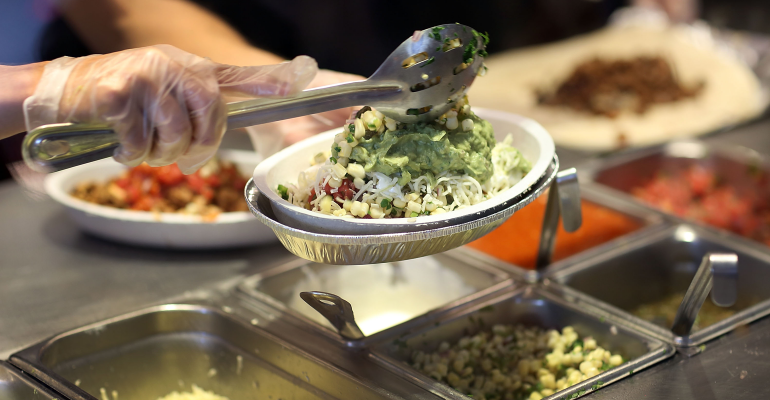Chipotle’s Q1 earnings results beat every estimate and were nothing short of impressive, particularly given a continued uncertain economic backdrop. While its comp growth of 10.9% is perhaps no surprise lapping last year’s omicron variant, the 4% jump in traffic is notable as prices remain about 10% higher year-over-year and as consumers grow increasingly anxious about the macro environment.
Chipotle’s quarter was buoyed by its operational improvements yielded from what it calls Project Square One. The program was put into place last summer to bring its workforce up to speed after two years of abnormally high, pandemic-induced turnover. Last July, Chipotle’s Chief Restaurant Officer Scott Boatwright said Project Square One is essentially about focusing on the little things – moving, listening, etc. – that add up during a peak volume window, making sure that staffing is maximized at the right time and, ideally, reducing those aforementioned turnover rates.
During the company’s Q1 call Tuesday, CEO Brian Niccol said turnover rates are now at their lowest level in five years.
“The stability of crew and managers and a return to shoulder-to-shoulder training is helping to translate Project Square One into results. As our teams are getting more experience, we are continuing to see improvements,” he said.
Of course, it helps that the chain has found favor in new products that haven’t included a whole lot of SKU or procedural introductions. Take, for instance, Chipotle’s fajita quesadilla launch in early March, inspired by TikTok creators Keith Lee and Alexis Frost. Niccol said the rollout nearly doubled the company’s quesadilla business and generated two of its top digital sales days ever.
“The results have been outstanding,” he said. “The best part is it is made of all existing ingredients, which limits additional complexity in our restaurants.”
Chipotle leveraged the same tactic with its chicken al pastor launch in early March, which features the chain’s existing adobo chicken cooked on the Plancha and then simply mixed in an al pastor marinate.
“This is also operationally simple to execute … This has allowed for an exciting new menu item while still maintaining our focus on Project Square One,” Niccol said, adding that crew member feedback about this simplicity has been positive.
This approach – new, buzzworthy menu introductions without additional noise – has worked remarkably for McDonald’s throughout the past three years. The quick-service giant’s successful Famous Orders platform, for instance, simply packages celebrities’ favorite meals based on already existing items. Taco Bell has also found success in reconfiguring existing ingredients into new menu offerings. Indeed, the tactic has perhaps become more effective in recent years as restaurants add more channels to the mix. Less SKUs mean less balls thrown into that demanding juggling act.
Niccol hinted that Chipotle will continue to seek out such simplicity in its menu launches, noting that “there’s still a lot of gems within the Chipotle menu.”
Despite finding this sweet spot on the menu and gaining traction from its operational strategy, Niccol said much work remains. Restaurants’ front makeline and digital makeline during peak periods is an opportunity area, for instance.
“We have noticed that when the digital makeline gets busy, our managers tend to pull a crew member from the frontline to help, which is impacting throughput,” he said.
Chipotle is currently testing adjustments to ensure more efficient deployment of this staffing based on pickup times. The company will continue this test as part of its stage-gate process, fine-tuning the process before rolling it out to more units.
“Early results show that we are increasing throughput on the frontline and increasing on time on the digital makeline without impacting sales,” Niccol said. “I can’t emphasize enough how important it is to have our digital makeline open from open to close, to have ingredients on that line from open to close, to being staffed and trained to get people down the line really fast. I can’t emphasize how important that is because everything then builds from there. When operations are running better, it helps all other drives of sales to perform better, such as menu innovation.”
The company is also deploying new equipment to improve its throughput. Its new clamshell grills are now in 10 restaurants, for example, and decrease the cooking time for chicken from 12-to-13 minutes to 2-to-3 minutes.
“That’s a big unlock for us because the grill position is one of the hardest positions to train,” Niccol said. “So, we can make that job easier and also free up more space on the Plancha, it just eliminates any potential bottleneck for our future growth.”
Chipotle is also in early days of mixing in Hyphen’s technology, which was part of the company’s Cultivate Next investments and is expected to automate the digital makeline. Niccol expects this deployment to improve accuracy, speed, and consistency.
“All these things are driving towards hopefully better guest experiences, but also a better work environment for employees,” Niccol said. “And then, obviously, I think it will be more efficient.”
Contact Alicia Kelso at [email protected]




